Physical Address
304 North Cardinal St.
Dorchester Center, MA 02124

Wondering what is an XML sitemap and how to create one on your WordPress website?
An XML sitemap helps search engines navigate your website content easily. It gives them a list of everything in a machine-readable format.
In this article, we will explain what an XML sitemap is and how to easily create one in WordPress.
An XML sitemap is a file that lists all of your website content in XML format so search engines like Google can easily discover and index the content on your website.
As early as the early 2000s, government websites had established a link on the front page called “site map”. This page usually contains a list of all pages on the site.
Although some websites still offer sitemaps in HTML format today, the overall purpose of sitemaps has changed.
Sitemaps are now in XML instead of HTML, and their target audience is search engines, not ordinary users.
In simple terms, an XML sitemap is a way for website owners to tell search engines about all the pages on their websites.
It also tells search engines which links on the site are more important than others, and how often the site should be updated.
Although XML sitemaps don’t improve search engine rankings, they allow search engines to better crawl your site’s content. This means more content can be found and displayed in search results, which leads to more search traffic and improved SEO rankings.
From a search engine optimization (SEO) perspective, a sitemap is very important.
Simply adding a sitemap will not affect search rankings. However, if a page on your website is not indexed, a sitemap lets search engines know about that page.
A sitemap is very useful when you are starting a blog or a new website since most new websites do not have backlinks, so it is difficult for search engines to discover everything.
This is why search engines like Google and Bing allow new websites to submit sitemaps in their webmaster tools. This allows their search engine bots to easily discover and index your content (more on this later).
For websites that already have a certain reputation, sitemaps are equally important. They allow you to decide which parts of your site are more important, which parts are updated more frequently, etc., so search engines can access and index your site’s content accordingly.
Next, let’s take a look at how to create an XML sitemap in WordPress.
There are several ways to create an XML sitemap in WordPress. We’ll show you three ways to create an XML sitemap in WordPress so you can choose the one that works best for you.
This method is very basic and has limited functionality.
Before August 2020, WordPress did not have a built-in sitemap feature. However, in WordPress 5.5, they released a base XML sitemap.
This way we can also automatically create XML sitemaps in WordPress without using a plugin. Simply add wp-sitemap.xml to the end of your domain name and WordPress will open the default XML sitemap page.

XML sitemap functionality has been added to WordPress by default, ensuring that any new WordPress site will benefit from an XML sitemap.
However, the feature isn’t very flexible, and you don’t have full control over what to add or remove from the XML sitemap.
Fortunately, almost all well-known WordPress SEO plugins have their own sitemap functionality. These sitemaps feel better, and you can remove unwanted content from WordPress XML sitemaps.
The easiest way to create an XML sitemap in WordPress is by using the All in One SEO plugin.
It is the best WordPress SEO plugin on the market, providing you with a comprehensive set of tools to optimize your blog posts for SEO.
First, you need to install and activate the All-in-One SEO plugin.
Note: AIOSEO free version also provides a site map function. However, to get advanced news sitemaps and video sitemaps, the Pro version is required.
Once activated, go to the “All in One SEO → Sitemaps” page to view the sitemap settings.
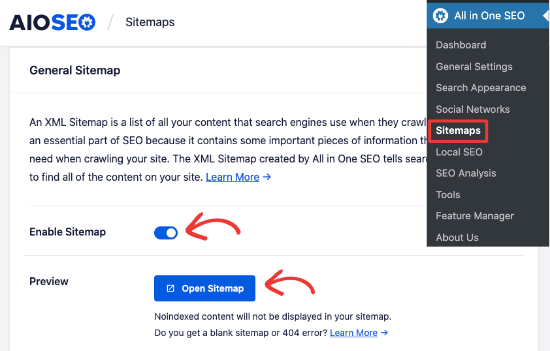
All-in-One SEO will enable the site map function by default and replace the site map that comes with WordPress.
You can click the Open Sitemap button to preview, or add “sitemap.xml” (for example www.example.com/sitemap.xml) behind the website to open the sitemap page.
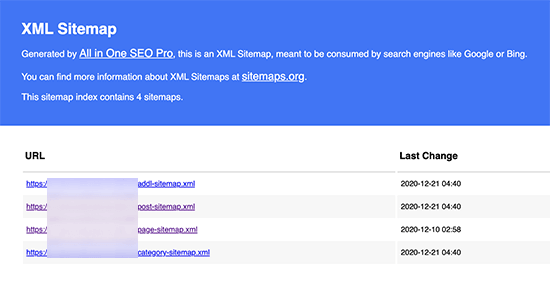
As a novice, you don’t need to touch any options, because the default settings are suitable for all types of websites, blogs, and online stores.
However, you can customize the sitemap to control what content is included in the sitemap.
Scroll down to “Sitemap Settings”.
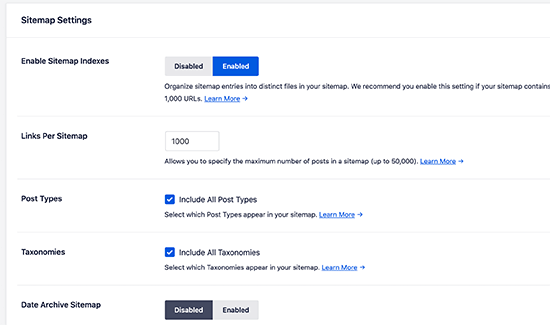
This settings section allows you to manage sitemap indexing options, such as whether to include all article types, categories, etc. You can also enable sitemaps for date-based archives and author archives.
All-in-One SEO automatically includes all WordPress content in an XML sitemap. But what if your website has some stand-alone pages that are not part of WordPress? Examples are external contact forms, landing pages, or Shopify store pages.
OK. AIOSEO is the only plugin that lets you add external pages to your WordPress sitemap. Just scroll the page to the “Additional Pages” section and open it. Here you can add any custom pages you want to include in your sitemap.

Just enter the URL of the page and set the priority. The lowest priority is 0.0, and the highest is 1.0. If you are not sure how much to fill, we recommend using 0.3.
Next, select how often the page will be updated and the date it was last modified.
If you need to add more pages, you can click the Add New button to continue adding. Finally don’t forget to save the changes you made.
All-in-One SEO lets you remove any article or page from your XML sitemap. You can set it in the “Advanced Settings” section under “All in One SEO → Sitemaps”.

You can also remove this link from the XML sitemap by setting the article to noindex, nofollow. This will prevent search engines from displaying the content in search results.
Just scroll to the AIOSEO Settings section below the editor when editing the articles or pages you want to exclude.

Switch to the Advanced tab and check the No Index and No Follow options.
All-in-One SEO can also help you create other types of sitemaps, such as video sitemaps or news sitemaps.
If you frequently embed videos in blog posts or pages, you can create a video sitemap. It enables search engines to display content with video thumbnails in search results.

You can also create a news sitemap if you run a news website and want to appear in Google News search results.
Simply go to “All in One SEO→Sitemaps” and switch to the “Video Sitemap” or “News Sitemap” tab to generate these sitemaps.
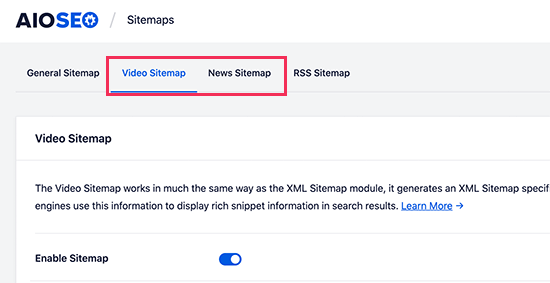
Overall, AIOSEO is the best WordPress plugin because it offers the most flexibility and powerful features at an affordable price.
If you use Yoast SEO as an SEO plugin for WordPress, it will also automatically generate an XML sitemap for you.
First, you need to install and activate the Yoast SEO plugin.
Once activated, go to “SEO→General” and switch to the “Features” tab. Here, scroll down and find the “XML Sitemap” option and turn it on. Remember to save your changes at the end.

To verify that Yoast SEO actually generated an XML sitemap, you can click on the question mark next to the XML sitemaps tag.

Then, click the See the XML sitemap link to view the XML sitemap generated by Yoast SEO.
You can also add sitemap_index.xml after the domain name to open the site map page. For example:
https://www.example.com/sitemap_index.xml
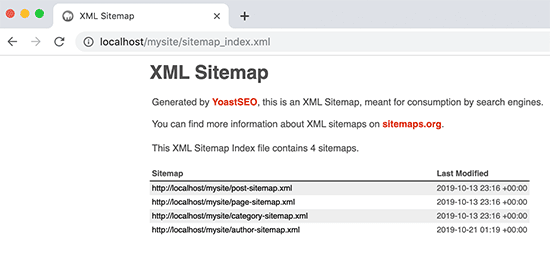
Yoast SEO creates multiple sitemaps for different types of content. By default, it generates separate sitemaps for posts, pages, authors, and categories.
Well, the above are the three methods on how to generate an XML site map. Hope this article answered all your questions about XML sitemaps and how to create an XML sitemap for your WordPress site.